
When you're on the hunt for an engagement ring, your first order of business is to chose what diamond shape you'd like. The shape you choose has the most noticeable impact on the overall look of the ring. Some shapes are dazzling and modern while others hearken to vintage designs. Luckily, choosing a diamond shape is largely based on style and personal preference.
Of all the characteristics which come into play when choosing your diamond, your recipient is likely have the strongest feelings about its shape. It's a smart idea to check in with your loved one to see if they have a favorite from the start. Other attributes that you'll consider later (like size, color and clarity) will have a more significant impact on the price tag and can be fine tuned down the line.
The shape of a gem is sometimes referred to as its cut. You may have heard of this as a friend gushed about her asscher cut solitaire or her princess cut earrings. In this case, it's not to be confused with the rating for "diamond cut" that you'll see on a grading certificate. In those instances, the cut refers to its polish, symmetry, and proportions—although gem shape and diamond cut are definitely linked.
If you want a refresher on your gemstone terminology, you can always refer to my previous article, Anatomy of a Diamond, to brush up before reading on.
ROUND
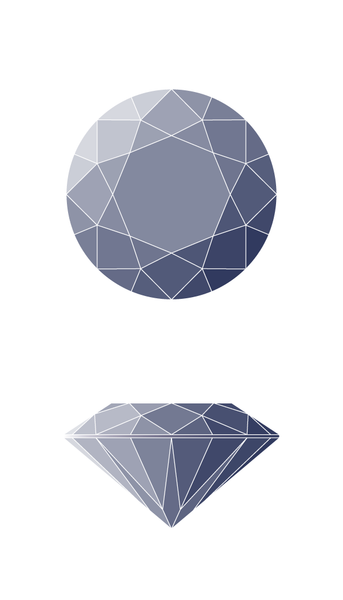
Round brilliant diamonds are the most popular diamond shape and by a wide margin. It’s estimated that they make up more than 70% of all the diamonds sold today. The faceting pattern of a brilliant diamond is optimized for sparkle, featuring 58 individual facets. Their popularity lies in their symmetrical shape, timeless character, and their excellent dispersion of light.
Look for: Brilliance, Symmetry, Clarity
OVAL

The modern oval cut is a variation of the round brilliant cut diamond. Its 58 facets are stretched into a symmetrical oval silhouette. This elongated cut maximizes the look of its carat weight. Diamonds of the same carat weight in a round cut appear smaller than they do as ovals. This diamond shape is an excellent choice for a woman with small hands since the stretched out shape lengthens the look of one’s fingers.
One caveat of the oval shape, which is also present in other elongated cuts such as the pear and marquise, is what is known as the bow-tie effect. This is a shadow created by the light passing through the stone which casts a shadow into the bottom facets. This can be remedied by a mindful cutting job that pays special attention to dispersing light throughout the pavilion.
Look for: brilliance, limited bow-tie effect
PEAR

The pear cut's teardrop shape is a hybrid of the modern round brilliant and the marquise diamond. When choosing a pear diamond, good symmetry and proportions are important to achieve a gem that is brilliant. When worn in a north-south orientation, the pear shape has an elongating effect on fingers similar to oval cut gems. Pear-shaped gems typically have 58 facets.
Look for: symmetry, brilliance, limited bow-tie effect
MARQUISE
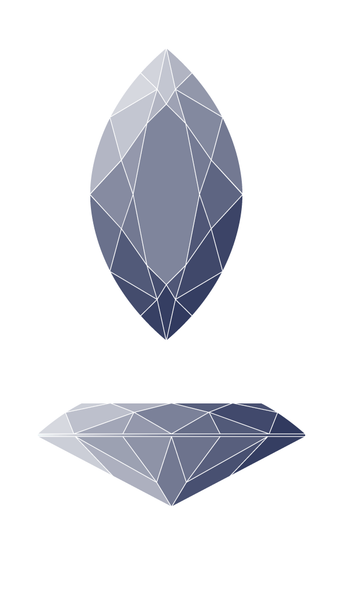
The marquise is another brilliant cut gem with 58 sparkling facets that come to a dramatic point at each end. Similar to oval shapes, the marquise maximizes the look of its carat weight with this stretched out shape. Marquise cuts have the largest surface area of any diamond. The length and pointed ends of a marquise will make fingers appear long and slender.
Look for: pleasing proportions, limited bow-tie effect
PRINCESS

The contemporary princess-cut diamond is the second most popular diamond shape on the market. Of all the square diamond shapes, the princess cut is most brilliant. These diamonds feature between 57 and 76 facets which are arranged in a manner similar to the round diamond for maximum sparkle and fire. Princess cuts are ideally square but can be found in pleasing rectangular silhouettes as well.
Look for: brilliance, pleasing proportions
CUSHION
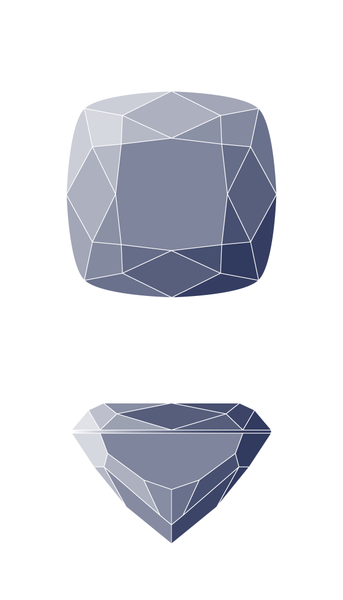
Available in either square or rectangular silhouettes, these pillow-shaped diamonds have broad facets and rounded corners. Cushion diamonds merge the style of old mine cut diamonds with modern ovals for a fresh take on a vintage look. The large 58 facets of a cushion-cut diamond sparkle more like antique diamonds with broad pops of light rather than the disco ball sparkle achieved by modern brilliant stones.
Look for: clarity, color
RADIANT

Radiant gems blend the silhouette of an emerald-cut diamond with the fire and brilliance of a modern round. They can be found in square or rectangular silhouettes and have distinctive trimmed corners. Due to the faceting pattern on the pavilion, radiant gems are often cut with a deeper profile than other gems to achieve the best sparkle.
Look for: brilliance, pleasing proportions
EMERALD
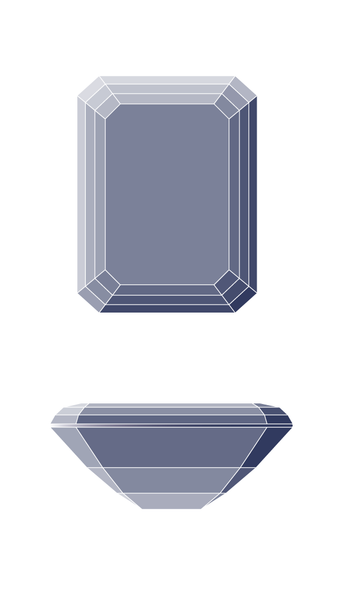
A rectangular shape with trimmed corners, emerald cuts feature long flat facets that resemble stair steps when viewed from above. Emerald cuts usually feature 57 facets, although this number can vary if extra "steps" are added to the gems crown or pavilion.
The broad facets of the emerald sparkle in a manner that is more linear and less busy than a brilliant cut diamond. The wide, flat facets allow you to see within the stone, so opt for a stone with higher clarity and color when choosing an emerald cut.
Look for: clarity, color
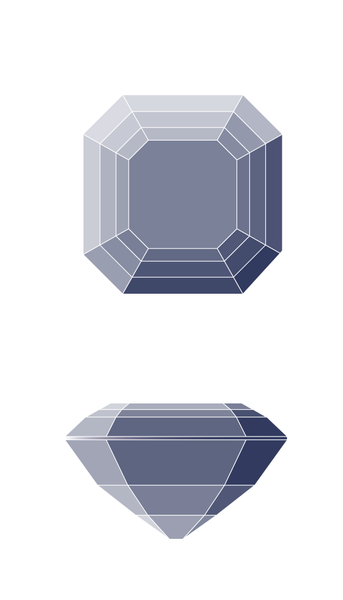
ASSCHER
Asscher-cut diamonds are noteworthy for their high crowns, small tables, and step-cut pavilions similar to an emerald cut. These square cuts have an excellent dispersion of light and a unique geometric sparkle. Asscher diamonds feature trimmed corners similar to radiant and emerald-cut stones. A traditional asscher features 58 facets, while a patented Royal Asscher cut diamond has 74.
Look for: clarity, color
BAGUETTE

Baguette cuts are most commonly used as accent stones and feature long, rectangular facets similar to an emerald-shaped gem. These facets are few—only 14—and are arranged in a linear step pattern. Similar to emerald shapes, the clarity and color are most important when choosing an appealing baguette. Baguettes are found in straight rectangles or trapezoid shapes known as tapered baguettes.
Look for: clarity, color
TRILLION

Trillion (or Trilliant) shaped diamonds have a signature triangle shape with equilateral sides. When used as a center or stand-alone diamond, trillions will often have convex sides with extra facets. When cut as side stones, these outer edges are usually made flat. Trillion diamonds have excellent sparkle and strong geometry. They typically feature anywhere from 31 to 50 facets.
Look for: brilliance, color
HEART
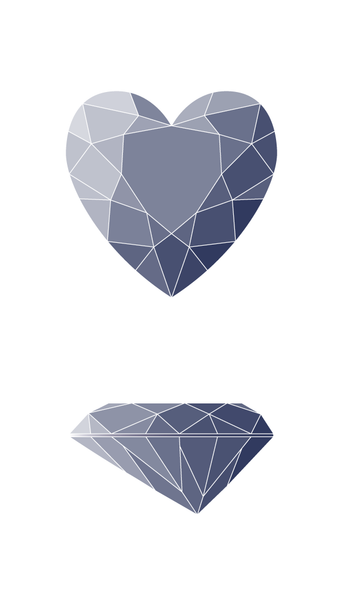
This distinct diamond shape is more commonly used for novelty and fashion designs than in engagement rings. Due to the complexity of the facets on a heart-shaped gem, it is important to choose a stone that appears evenly shaped and brilliant with a good ratio of length to width.
Look for: evenly dispersed brilliance and color, pleasing proportions



